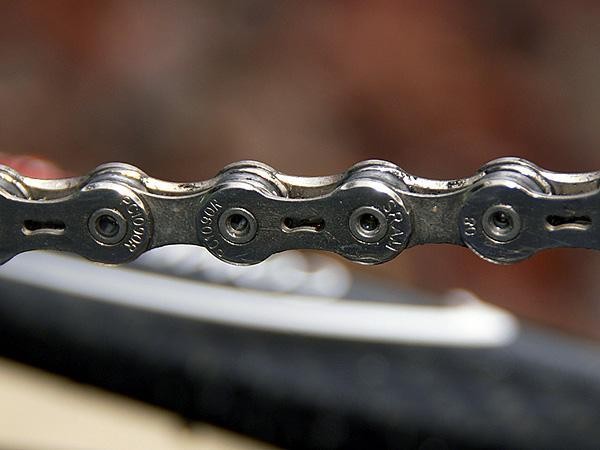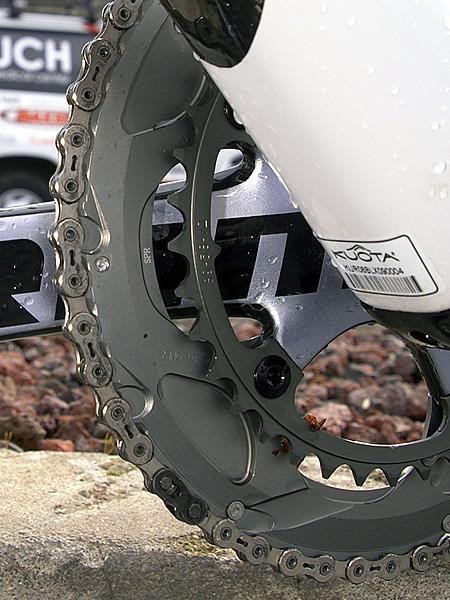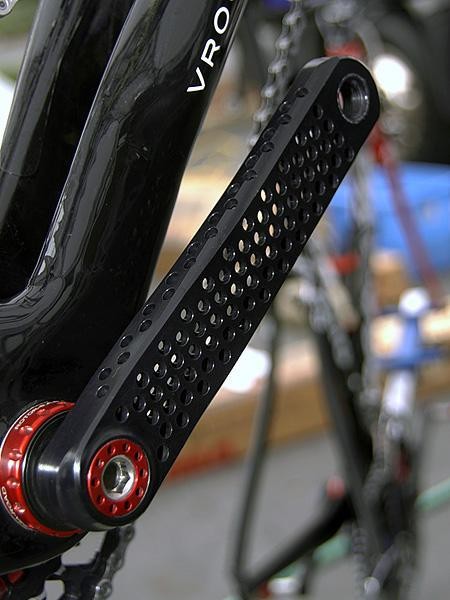New gear for the new season
SRAM had taken a PR hit over the past couple of years – mostly from us – as many of their sponsored...



Race tech: Tour of California, February 14, 2009
SRAM-sponsored teams with updated chains and beefier chainrings
SRAM had taken a PR hit over the past couple of years – mostly from us – as many of their sponsored riders and teams had actually been subbing in other companies' chains, cassettes and chainrings instead of the official Red pieces for any number of reasons. However, that seems to have changed for the 2009 season as there were virtually no mismatched drivetrains to be found (and believe us, we looked).
Criticisms surrounding the existing PC-1090R chain were mostly limited to insufficient strength and excessive noise but both have been addressed with the latest version whose improvements were iteratively tested by teams last year and have already been put into production. A new pin material and revised riveting process improves pull strength while an increase grease fill during manufacture quiets things down and retains lubrication longer from frequent washings.
Stronger riders were also having some issues with Red's outer chainrings during peak efforts but SRAM has addressed that as well with a new 'SPR' variant that is milled less aggressively than the stock version for reduced flex, gaining 25-30g as a result. Though the SPR ring clearly won't appeal to the weight weenies, SRAM road sports team and athlete liaison Alex Wassmann insists that it will be “overkill for most of us turning the pedals in search of bliss rather than anger and salary.” Perhaps, but even less serious riders are likely to benefit from the improved front shifting that the new ring would provide.
And what about the Red PowerDome cassettes? There were actually no changes made that we could see and none that the team mechanics we spoke to were aware of any but the bikes we viewed were appropriately fitted nevertheless.
Prototype Shimano carbon brake blocks for Rabobank
Get The Leadout Newsletter
The latest race content, interviews, features, reviews and expert buying guides, direct to your inbox!
Remember those mysterious blue brake pads we spotted on Rabobank team bikes during last year's Tour de France? We didn't know what they were back then but we do now: they're prototype carbon-specific blocks from team sponsor Shimano.
The new pads are intended as an eventual replacement for the company's existing carbon-specific compound and in typical Shimano style, are aimed directly at the top slot currently occupied by SwissStop's ubiquitous Yellow King. According to Rabobank team mechanic Joost Hoetelmans, the blue pads provide much better braking in wet conditions than the current Shimano block as well as a modest improvement in dry, too. And though the 'fingernail test' showed the new compound to be far softer than before, Hoetelmans also said they wear longer and the riders report a better feel at the lever.
Unfortunately, there is no word on when the new pads will actually be available to the public though if the situation with the Rabobank boys is any indication it will be a little while yet. Even they aren't able to get as many sets as they'd like.
A closer look at Carlos Sastre's Rotor prototype cranks
Recently we gave you a quick look at Carlos Sastre's (Cervélo Test Team) prototype Rotor cranks but information on them was decidedly scarce at the time. Though they appeared to be hollow-forged cranks with a smattering of holes drilled in them to save weight, it turns out that we were only partially correct. The crankarms are indeed hollow and forged and the holes do save weight, but the order of operations is not what you would expect and is what makes these special.
The arms actually start out as solid forgings, not hollow ones. Holes are then drilled clean through the arms from both the sides and outer faces but their diameters, directions and locations are carefully selected such that the overlapping intersections leave virtually zero material in the crank interior. The result is effectively a hollow-forged part with a liberally perforated skin plus an indisputably distinctive appearance.
It remains to be seen how well the novel cranks actually perform but regardless, the concept is ingeniously original. In fact, not only does it apparently avoid infringing on anyone else's patents but Rotor has filed one of its own.
Rotor insists that Sastre's crank is still only a development mule, however, and though the manufacturing process has a name the item itself still does not. In fact, Rotor co-founder Pablo Carrasco said that the 2008 Tour de France champion won't even be using it in competition here at the Tour of California.